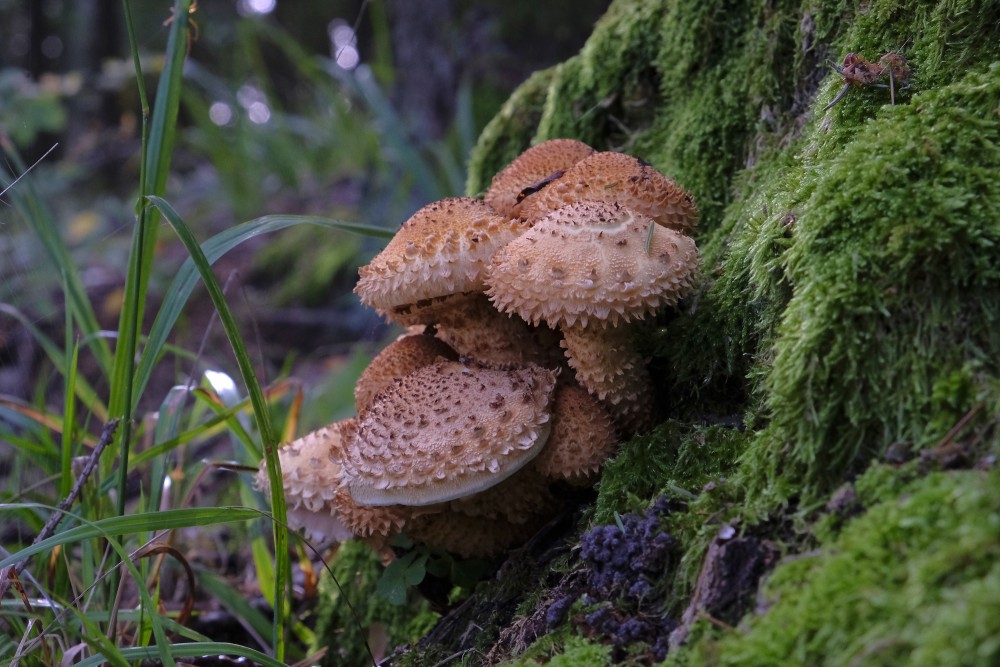Pholiota squarrosa
Pholiota squarrosa, commonly known as the shaggy scalycap, the shaggy Pholiota, or the scaly Pholiota, is a species of mushroom in the family Strophariaceae. Common in North America and Europe, it is often an opportunistic parasite, and has a wide range of hosts among deciduous trees, although it can also infect conifers. It can also live as a saprobe, deriving nutrients from decomposing wood. The mushroom is typically found growing in clusters at the base of trees and stumps. Both the cap and the stem are covered in small, pointed scales that are pointed downward and backward. The crowded gills are yellowish, then later rust-brown. The mushroom has an odor that, depending on the author, has been described as resembling garlic, lemon, radish, onion, or skunk. It has a strong taste, resembling radishes. Though edible to some, it may be toxic, especially if consumed in combination with alcohol. The mushroom contains unique chemicals thought to help it infect plants by neutralizing defensive responses employed by them. The very similar P. squarrosoides differs in having a paler cap that is sticky between the scales, and smaller spores.
| Pholiota squarrosa | |
| Kingdom: | Fungi |
| Division: | Basidiomycota |
| Class: | Agaricomycetes |
| Order: | Agaricales |
| Family: | Strophariaceae |
| Genus: | Pholiota |
| Species: | P. squarrosa |
Description
Like other Pholiota mushrooms, P. squarrosa has a scaly cap and stem. The cap ranges from 3 to 12 cm (1.2 to 4.7 in) in diameter, and depending on its age, can range in shape from bell-shaped to rounded to somewhat flattened. The cap color is yellowish-brown to tawny in older specimens. The scales on the cap are yellowish to tawny, and recurved.
The stem is 4 to 12 cm (1.6 to 4.7 in) long by 0.5 to 1.5 cm (0.20 to 0.59 in) thick, and roughly equal in width throughout. The partial veil that covers the young gills forms a thick, woolly ring on the upper part of the stem. Above the level of the ring, the stem is bare, while below it is scaly like the cap. The gills are covered by a partial veil when young and have a greenish-brown color; mature gills are rusty brown. They are crowded closely together, attached to the stem (adnate), and usually notched (sinuate).
The spore print is cinnamon or rusty brown. The spores are elliptic, smooth-walled, nonamyloid (not absorbing iodine when stained with Melzer's reagent), and measure 6.6–8 by 3.7–4.4 μm. The basidia (spore-bearing cells) are club-shaped, and four-spored, with dimensions of 16–25 by 5–7 μm.
Fruit bodies have an odour described variously as resembling garlic, radish, lemon, onion, or skunk, and taste like radish.
Edibility
Although some sources report P. squarrosa as edible, the mushroom has caused several cases of poisoning. The afflicted individuals had consumed alcohol with the mushroom, then experienced vomiting and diarrhoea about ten hours later. The toxic effect may be due to the combination of eating the mushrooms and taking alcohol, although the extended time delay between consumption and symptoms suggests the mechanism of toxicity is different than the antabuse-effect experienced from Coprinopsis atramentaria with alcohol.
en.wikipedia.org
